

How The Military Could Turn Your Mind Into The Next Battlefield. Actually, the reason I think they won't happen is that most talk of nanotech and cybernetics and such is more science fiction than science fact.

Moving forward into the future won't change the laws of physics, and thus won't change the practicality of any technology. Its like the article that ran about comparing 3D printers to Star Trek's replicators. The two technologies aren't comparable, because the Star Trek replicator requires matter teleportation for its mode of assembly, and that breaks known physics. More money, more guns: Asia's military budgets surge as armies go high-tech- Nikkei Asian Review. SYDNEY -- On two recent occasions, a pair of Sukhoi Su-30 fighters have taken off from their base near the old Indonesian trading port of Makassar and flown far across the Indonesian archipelago to intercept unidentified aircraft.
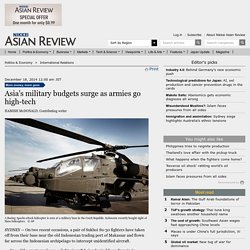
One of the mystery planes, a light aircraft being ferried from Darwin in northern Australia to its new owners in the Philippines, was chased a long distance before being forced to land in Manado, a city on the Indonesian island of Sulawesi. The other, an executive jet flying Saudi officials to Brisbane ahead of the Group-20 meeting, was ordered to land in the Indonesian city of Kupang on the island of Timor.
In both cases, fines were imposed and the planes were allowed to continue to their destinations. It is unclear whether the Indonesian pilots could have taken any hostile action, since missiles have not yet been delivered for the Russian-made jets. Ready to rumble. China moves ahead to develop sixth-generation fighter|Politics|News|WantChinaTimes.com. Concept art for the US Navy's FAXX fighter.
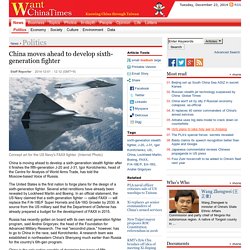
(Internet Photo) China is moving ahead to develop a sixth-generation stealth fighter after it finishes the fifth-generation J-20 and J-31, Igor Korotchenko, head of the Centre for Analysis of World Arms Trade, has told the Moscow-based Voice of Russia. The United States is the first nation to forge plans for the design of a sixth-generation fighter. Several artist renditions have already been revealed by Lockheed Martin and Boeing.
More money, more guns: Asia's military budgets surge as armies go high-tech- Nikkei Asian Review. China’s Rise as Arms Supplier Is Put on Display. Photo ZHUHAI, China — Queen Bee anti-tank rocket system.

Halberd supersonic target drone. Sky Dragon 12 surface-to-air missile system. India, Vietnam decide to step up security, defence ties. China’s Submarines Add Nuclear-Strike Capability, Altering Strategic Balance. DoD Shifts Acquisition, Tech Efforts Toward Major Powers. WASHINGTON — After spending 13 years fighting non-state actors in Iraq, Afghanistan and Syria, the US Defense Department is shifting its institutional weight toward developing a new acquisition and technology development strategy that focuses more on major state competitors, the Pentagon’s No. 2 told Defense News on Nov. 21.

Deputy Defense Secretary Bob Work said that at the top of the agenda are powers like China and Russia, both of whom have “regional and global aspirations, so that’s going to increasingly take a lot of our attention.” Next come regional states that want to become nuclear powers, such as Iran and North Korea, and finally are transnational terrorist groups and their myriad offshoots. A major part of this push is the new “offset” strategy, which is looking to identify new technologies that the United States can use in order to deter or defeat those threats. Chinese Military Modernization and Force Development: Chinese and Outside Perspectives. The Burke Chair at CSIS has updated its analysis of the trends in Chinese military strategy and forces entitled Chinese Military Modernization and Force Development: Chinese and Outside Perspectives.

China Creates New ‘Asia for Asians’ Security Forum. China Challenges Obama’s Asia Pivot With Rapid Military Buildup. President Barack Obama’s trip to Asia this week will be dominated by a country he’s not even visiting: China.

Each of the four nations on the president’s itinerary is involved in territorial disputes with an increasingly assertive China. And years of military spending gains have boosted the capabilities of the People’s Liberation Army faster than many defense analysts expected, casting a shadow over relations between China and its neighbors and sparking doubts about long-term prospects for the U.S. presence in the Pacific. “There are growing concerns about what China is up to in the maritime space,” said Bonnie Glaser, a China expert at the Center for Strategic and International Studies. Research - The Time Is Ripe for Stronger U.S.-Japan Military Ties - Hudson Institute. China’s Deceptively Weak (and Dangerous) Military. China Challenges Obama’s Asia Pivot With Rapid Military Buildup. The Political Utility of China’s A2/AD Challenge. Anti-Access/Area Denial is often seen purely in military terms.
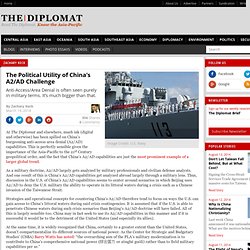
It’s much bigger than that. At The Diplomat and elsewhere, much ink (digital and otherwise) has been spilled on China’s burgeoning anti-access area denial (A2/AD) capabilities. This is perfectly sensible given the importance of the Asia-Pacific to the 21st Century geopolitical order, and the fact that China’s A2/AD capabilities are just the most prominent example of a larger global trend. As a military doctrine, A2/AD largely gets analyzed by military professionals and civilian defense analysts. And one result of this is China’s A2/AD capabilities get analyzed abroad largely through a military lens.
Strategies and operational concepts for countering China’s A2/AD therefore tend to focus on ways the U.S. can gain access to China’s littoral waters during said crisis contingencies. Abe’s aid reform, in the name of peace? Author: Fumitaka Furuoka, University of Malaya On 26 June 2014, a panel of specialists under Japanese foreign minister Fumio Kishida submitted a report that recommended transforming Japan’s foreign aid policy into a ‘strategic’ diplomatic tool.
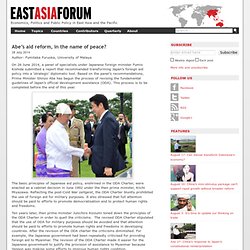
Based on the panel’s recommendations, Prime Minister Shinzo Abe has begun the process of revising the fundamental guidelines of Japan’s official development assistance (ODA). This process is to be completed before the end of this year. The basic principles of Japanese aid policy, enshrined in the ODA Charter, were enacted as a cabinet decision in June 1992 under the then prime minister, Kiichi Miyazawa. Japan gives Vietnam six navy ships amid regional tension. Increased military cooperation between China and India a sign of warming ties. In his first official visit to China, Indian Army Chief General Bikram Singh has called on both countries to be partners in mutual benefits.
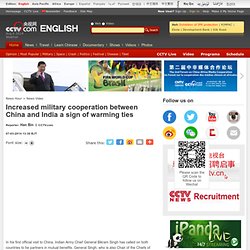
General Singh, who is also Chair of the Chiefs of Staff Committee of the Indian Armed Forces will be in several high level meetings during his four-day visit. He says his hoping to further improve ties with the Chinese military during his visit. Another sign of warming ties between China and India. How A2/AD Can Defeat China. A new report by the Rand Corporation calls for turning China’s A2/AD strategy on its head. Most of the debate that has surrounded the emergence of China as a major military player in the Asia-Pacific has focused on the People’s Liberation Army’s (PLA) development of an anti-access/area-denial (A2AD) strategy and its potential impact on a U.S.
-led regional security architecture that remains anchored to old concepts. As China expands its military capabilities and, alongside those, its claims to various territories within the region, the PLA has developed and fielded a variety of platforms that are intended to deter and delay external intervention by U.S. forces in, say, an armed conflict in the Taiwan Strait.
The much-discussed Dong Feng 21D (DF-21D) anti-ship ballistic missile (ASBM), which could theoretically threaten a U.S. carrier battle group on its way to the region, is at the core of such a strategy. For obvious reasons, proposing such an alliance would be controversial. Japan, France agree on development, exports of weapons. PARIS--Japan agreed with France to set up joint committees to discuss development of military equipment and management of weaponry exports in hopes of containing China’s rapid expansion in the East China Sea. The decision was reached here Jan. 9 during the first “two-plus-two” dialogue between the two countries’ foreign and defense ministers. “(The agreement) will open up a new dimension for our cooperation on security and defense,” Japanese Foreign Minister Fumio Kishida said after the meeting. New Komeito: if Japan enters a combat zone, turn right ‘round and come on home.
Big things are afoot in Tokyo, as Prime Minister Shinzo Abe’s government nears a milestone in its attempts to make Japan a more normal country on national defence. Abe wants to allow Japan limited exercise of the right of collective self-defence, through reinterpretation of country’s pacifist constitution. His party, the LDP, is in intensive discussions with its coalition partner, New Komeito, in order to get a final deal approved by 22 June.
The United States will accept and support whatever results from Japan’s sovereign democratic process—especially as any progress on the long-time sticking point of collective self-defence is better than none. But in a disappointing development, the LDP appears to have made a concession that forecloses an immense opportunity to advance the US–Japan alliance to new levels of coordination, interoperability and, ultimately, efficacy. Negotiations aren’t over until they’re over, but if present reports are accurate, the question then becomes: so what? China under-reports defence spending, says US. 5 June 2014Last updated at 23:30 ET The US said China was modernising drones, warships and cyber weapons China has under-reported its 2014 defence spending by about 20%, according to an annual report put out by the US defence department.
Report: Chinese Cruise Missiles Could Pose Biggest Threat to US Carriers. TAIPEI — Saturation strikes from Chinese anti-ship cruise missiles could become the biggest threat to US Navy carrier strike groups (CSG), according to a paper issued by the Center for the Study of Chinese Military Affairs at the National Defense University.
The paper, “A Low-Visibility Force Multiplier: Assessing China’s Cruise Missile Ambitions,” draws from both Western and Chinese-language open source documents and concludes, “experienced Aegis warriors will respect China’s emerging capabilities.” Written by cruise missile specialist Dennis Gormley, and China military specialists Andrew Erickson and Jingdong Yuan, the paper states that, due to the low cost of developing, deploying and maintaining cruise missiles, the Chinese believe that cruise missiles possess a 9:1 cost advantage over the expense of defending against them. China assumes that “quantity can defeat quality” by simply saturating a CSG with a variety of high-speed, low-altitude, cruise missiles.
China’s Advance Spurs Indonesian Military Shift: Southeast Asia. China’s intensifying move to assert claims over the South China Sea has given fresh impetus to a military buildup in Indonesia that will see its forces deployed with greater focus on external risks. China’s Advance Spurs Indonesian Military Shift: Southeast Asia. Washington Considers Missile-Defense System in South Korea - WSJ. Japan Moves to Scale Back Postwar Restrictions on the Use of Military Power. Photo PUSAN, South Korea — Prime Minister Shinzo Abe may be about to take one of his biggest steps yet to nudge Japan away from its postwar pacifism after a government advisory panel recommended Thursday that constitutional restrictions on the military be eased to allow Japanese forces to come to the aid of allied nations under attack.
Japan Moves to Scale Back Postwar Restrictions on the Use of Military Power. Ctrl + Alt + Delete. Today's U.S. military is the product of history -- not of the missions and threats it now faces. American forces are hampered by overlapping roles and missions, arcane organizational structures, Cold War platforms and programs, and recruiting practices detached from modern needs. If it were starting fresh, this is not the military the United States would build. How Putin Is Reinventing Warfare. The Kremlin, according to Barack Obama, is stuck in the "old ways," trapped in Cold War or even 19th century mindsets. But look closer at the Kremlin's actions during the crisis in Ukraine and you begin to see a very 21st century mentality, manipulating transnational financial interconnections, spinning global media, and reconfiguring geo-political alliances. World Cuts Back Military Spending, But Not Asia. Armed Conflicts, Asia-Pacific, Featured, Global Geopolitics, Headlines, North America, Peace, TerraViva United Nations, Trade & Investment.
How Putin Is Reinventing Warfare. Asia-Pacific Continues to Lead Global Weapons Imports. India, China and Pakistan lead for global arms imports. The Asia-Pacific accounts for 47 percent of all imports. The Stockholm International Peace Research Institute (SIPRI) released its “Trends in International Arms Transfers, 2013” report documenting major arms exports among world nations. It finds that the global market for major weapons grew by 14 percent in the 2009-2013 period compared to the 2004-2008 period. The Asia-Pacific region, including Oceania, led in imports, accounting for 47 percent of all global major weapon imports. More specifically, South Asia accounted for 45 percent of the regional total, East Asia 27 percent, Southeast Asia 23 percent, and Oceania 8 percent.
The Chinese Military Can 'Fight Any Battle and Win' On March 24, a 13-year veteran of Bloomberg News, Ben Richardson, an editor at large for Asia news, resigned in protest. A few days earlier, company Chairman Peter Grauer had said that the news and financial information services company founded in 1981 by Michael Bloomberg "had" to be in China and "should have rethought" some of its recent stories there. Grauer avoided specifics, but it seemed clear that he was referring to a series of investigative reports on wealth in China produced by Bloomberg journalists over the last year.